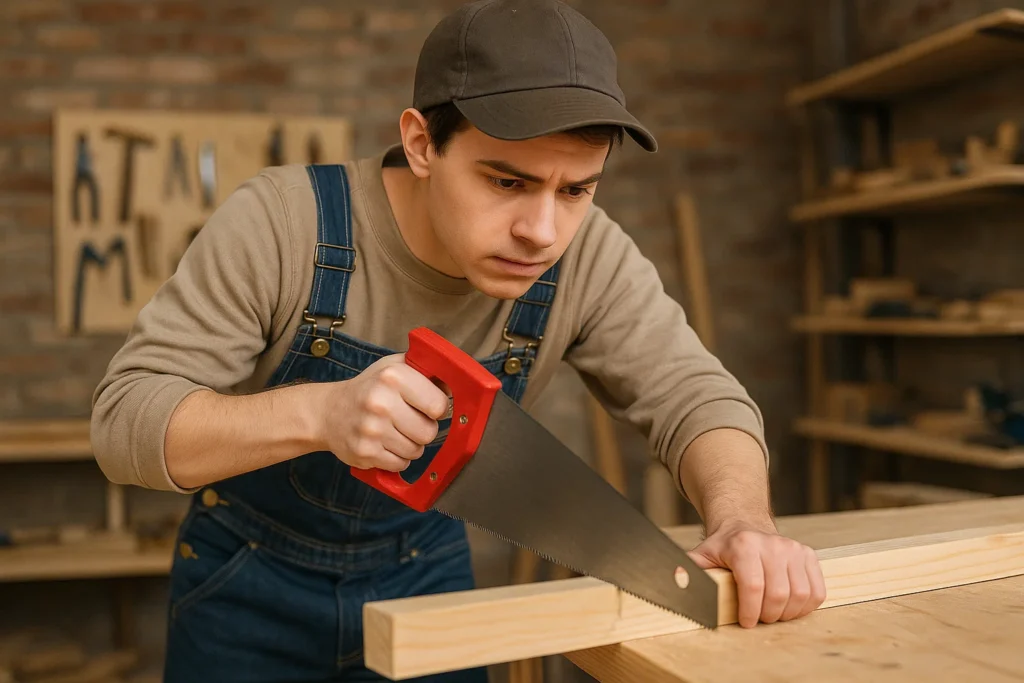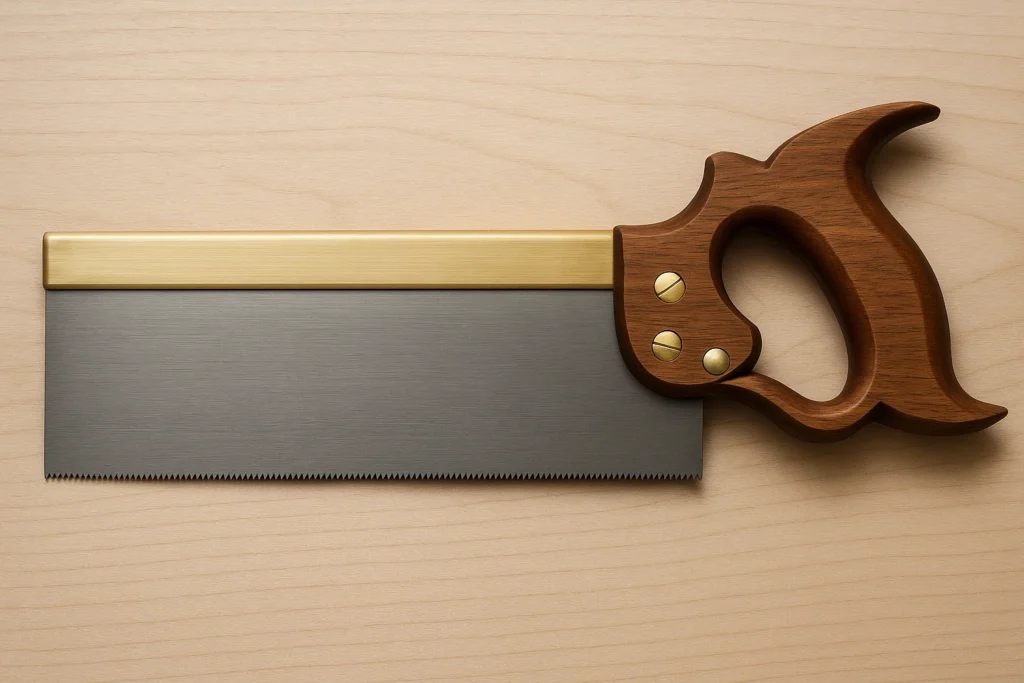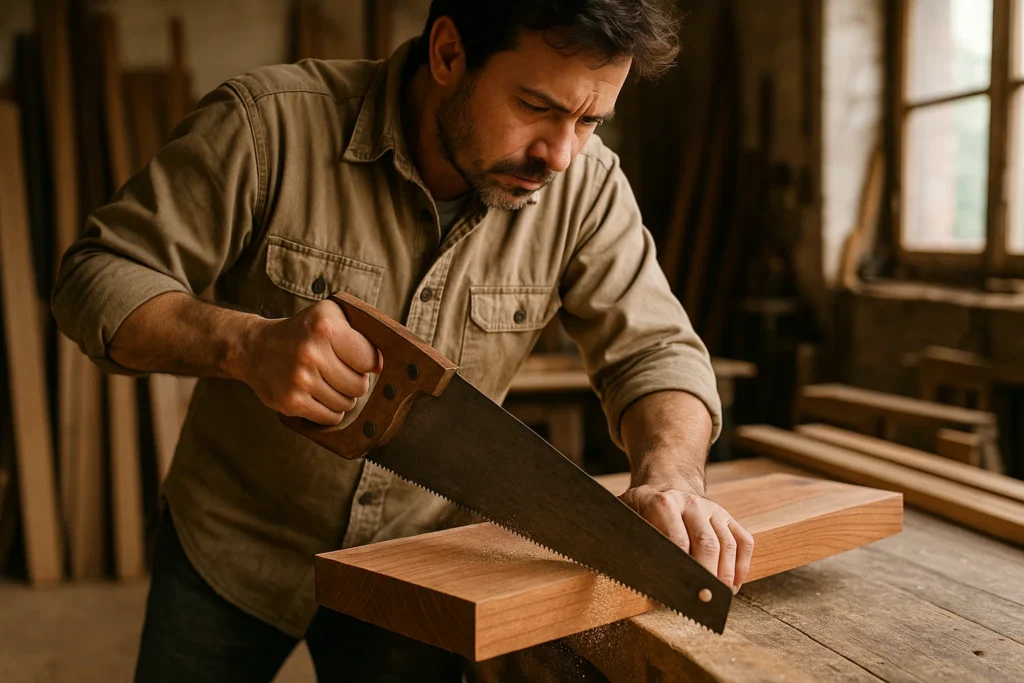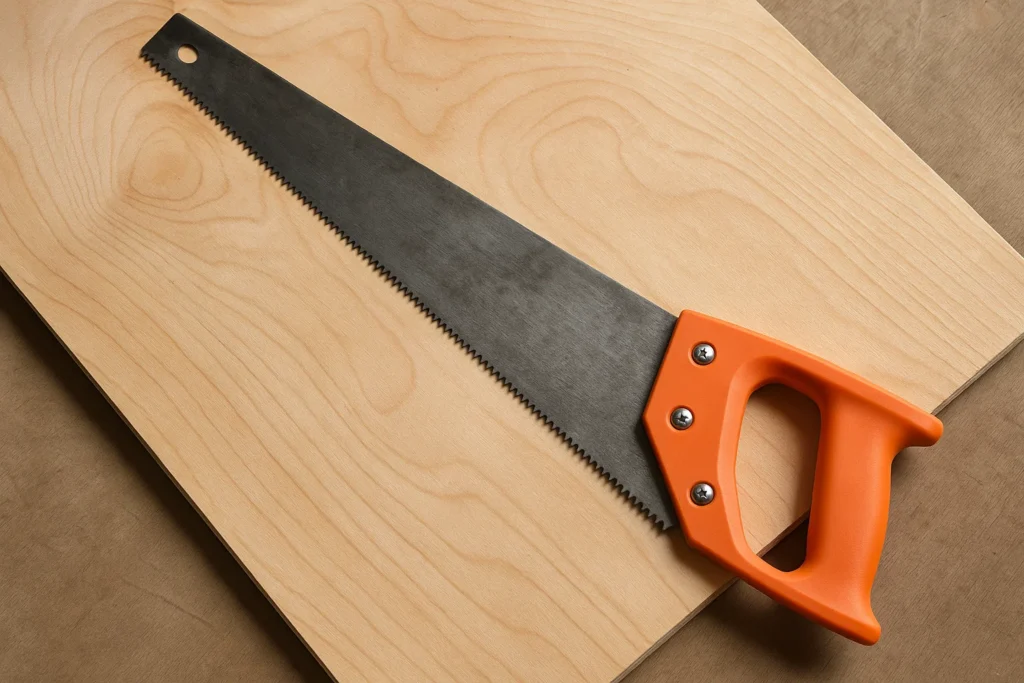Cutting MDF Can Wear Down Ordinary Saws
Cutting MDF can wear down ordinary saws fast and leave rough, chipped edges. Its fine fibers and resin act like sandpaper on blades and create lots of dust that clogs teeth and irritates lungs.
Choosing the right hand saw means cleaner cuts, longer blade life, and safer work.
This guide shows which saws handle MDF best and what to watch out for before you start cutting.
TL;DR
- MDF dulls blades faster than solid wood
- Choose hardpoint blades for longer sharpness
- Aim for 12 TPI or higher for clean cuts
- Triple‑ground teeth reduce chipping
- 16–20 in blades give smooth, even strokes
- Non‑slip, ergonomic handles cut fatigue
- Replaceable blades save money on heavy use
- Always clamp, score, and cut slowly for best results
Some or all Images are generated by AI for illustration.
Best Hand Saws For MDF
Hand Saw | Best For | Blade Length | TPI |
|---|---|---|---|
20 in (51 cm) | 11 TPI | ||
12 in (30.5 cm) | 11 TPI | ||
10 in (250 mm) | 6–10 TPI, 18 TPI | ||
6 in (150 mm) | 25 TPI | ||
6 in (152 mm) | 11 TPI, 17 TPI |
Note: We don’t test products ourselves. Instead, we go through user reviews and/or community discussions to find and recommend the best options.
1. Jorgensen Pro Hand Saw
A sharp, low‑friction 20 in hand saw with ergonomic handle and angle guides for precise, fatigue‑free MDF cuts. Durable blade resists wear, making it ideal for detailed woodworking.
Key Features
- Blade Length: 20 in (51 cm)
- TPI: 11 teeth per inch (11 TPI) for fast, fine‑cut performance
- Blade Material: High‑speed steel for long‑lasting sharpness
- Handle Type and Material: Ergonomic non‑slip ABS+TPE soft‑grip aluminum handle (reduces hand fatigue)
- Saw Type: Fine‑cut hand saw for precise, clean cuts
- Cutting Angle / Set: 45° and 90° auxiliary guide angles for accurate positioning
- Weight: 1.55 lbs (0.7kg)
Pros & Cons
Pros:
- Sharpness: Blade stays sharp after heavy use, delivering clean, precise cuts in MDF.
- Lightweight: Easy to maneuver for long periods, reducing hand fatigue during detailed cuts.
- Smoothness: Low‑friction coating lets the blade glide through material with minimal resistance.
- Durability: Hardened, black‑coated blade resists wear and rust, lasting through repeated jobs.
- Handle Comfort: Ergonomic ABS+TPE soft‑grip handle relieves hand strain during extended work.
- Marking Guides: 45° and 90° angle marks on the handle help align straight cuts accurately.
- Versatility: Fine‑cut teeth cleanly slice wood, PVC, drywall, and plant roots for varied tasks.
- Safe Storage: Plastic blade guard and cardboard sheath protect teeth and users when not in use.
Cons:
- Blade Flex: Thin blade can flex under pressure, reducing stability on thick MDF panels.
- Gardening Fit: Fine‑cut design slows cuts through roots or branches, limiting garden use.
- End Stability: Narrow tip offers less leverage; a wider end would improve control on long cuts.
Note: These pros and cons are based on user review trends and latent consensus.
Our Verdict
Reliable saw for clean MDF cuts.
Buy If:
- You need sharp, precise cuts on MDF panels.
- You plan extended cutting sessions and need minimal hand fatigue.
- You want built‑in angle guides for accurate edge alignment.
- You value a durable, low‑friction blade that resists wear.
Don’t Buy If:
- You work with very thick MDF panels prone to blade flex.
- You need maximum tip stability for long continuous cuts.
- You have a strict budget and seek a lower‑cost saw.
This Jorgensen hand saw excels at fine, accurate MDF work and stays comfortable over long jobs. Its low‑friction coating and angle marks boost precision, but consider a stiffer alternative for heavy‑duty or thick‑panel cutting.
2. WADFOW Pro Hand Saw
Lightweight 12 in hand saw with an 11 TPI high‑carbon blade and soft‑grip handle for fast, precise cuts. Ideal for small to mid‑size MDF and DIY tasks.
Key Features
- Blade Length: 12 in (30.5 cm) lets you cut through wide boards easily
- TPI: 11 teeth per inch (11 TPI) for fast, smooth cuts
- Blade Material: High carbon steel blade stays sharp and durable
- Handle Type and Material: Ergonomic non‑slip ABS+TPE soft‑grip handle reduces hand fatigue
- Saw Type: Hand saw designed for manual cutting of wood, drywall, and plastic pipes
- Cutting Angle / Set: 45° and 90° auxiliary angle guides on handle for accurate cutting
- Weight: 0.73 lb (0.33 kg) lightweight for easy handling
Pros & Cons
Pros:
- Sharpness: High-carbon steel blade stays sharp through multiple cuts, giving cleaner edges and less splintering on dense MDF panels.
- Speed: 11 TPI triple-ground teeth remove material quickly, letting you finish straight cuts in MDF faster.
- Control: Compact 12 in size and recessed handle give better leverage and precise guidance when trimming small MDF pieces.
- Comfort: Soft-grip ABS+TPE handle reduces hand fatigue during extended MDF cutting sessions.
- Portability: At just 0.73 lb (0.33 kg), it’s easy to carry between work areas or store in a hobbyist’s toolkit.
Cons:
- Blade-Length: Handle design uses about 2 in of the blade, leaving roughly 10 in for cutting, which can limit through‑cuts on larger MDF boards.
- Coarse-Teeth: 11 TPI produces a moderately rough finish that may require additional sanding for smooth MDF edges.
- Ergonomics: Feel of the non‑slip grip may not fully prevent slip in sweaty or dusty conditions, impacting control on detailed MDF cuts.
Note: These pros and cons are based on user review trends and latent consensus.
Our Verdict
Solid for small to mid‑size MDF cuts.
Buy If:
- You need fast, rough cuts on MDF panels.
- You work on small or detailed MDF pieces.
- You want a lightweight saw for easy transport.
- You value reduced hand fatigue during extended use.
Don’t Buy If:
- You require through‑cuts on large MDF sheets.
- You need a smooth edge without extra sanding.
- You want maximum blade reach for deep cuts.
This saw shines for hobbyists tackling small to medium MDF projects, offering speed and comfort on a budget. For larger panels or finish‑grade work, a finer‑tooth or longer‑blade alternative is better.
3. HURRICANE Pull Saw
Lightweight Japanese pull saw with a sharp SK5 blade and non‑slip handle for clean, precise MDF cuts. Budget‑friendly replaceable blade makes it a practical DIY choice.
Note: The described version may not be available. You may get redirected to a different version.
Key Features
- Blade Length: 10 in (250 mm)
- TPI: 6–10 TPI on fine cross‑cut side, 18 TPI on rip‑cut side
- Blade Material: SK5 steel
- Handle Type and Material: Comfort‑grip, non‑slip TPR handle
- Saw Type: Double‑edged Japanese pull saw
- Cutting Angle / Set: [Missing data]
- Weight: 9.9 oz (281g)
Pros & Cons
Pros:
- Sharp Cuts: SK5 blade delivers clean, precise slices through MDF with minimal effort, reducing sanding time.
- Lightweight Design: Ultra-thin, flexible blade and low weight cut fatigue on long projects.
- Secure Grip: Textured, non‑slip TPR handle offers firm control for straight, accurate cuts in sheet goods.
- Quick Assembly: Blade mounts and dismounts easily with the plastic thumb screw, simplifying storage and transport.
- Flush Cutting: Flexible, ultra-thin blade lets you cut nearly flush for clean edges on trim and panels.
- Budget Friendly: Low price makes replacement blades economical when teeth dull from heavy MDF use.
Cons:
- Kerf Tear: Set teeth can gouge or tear MDF surface on flush cuts, requiring extra filling or sanding.
- Blade Durability: Some users report the blade bends or breaks under tougher cuts, risking mid‑project failure.
- Initial Cleanup: New teeth may be slightly proud and need lapping or dressing to avoid surface scratches.
- Screw Wear: Plastic thumbscrew may loosen or strip over time if blade is removed frequently.
Note: These pros and cons are based on user review trends and latent consensus.
Our Verdict
A solid, budget-friendly pull saw for precise MDF work.
Buy If:
- You need clean, precise cuts with minimal sanding.
- You plan long sessions and want a lightweight, low‑fatigue tool.
- You require near‑flush cuts on edges and trim.
- You value an economical replaceable‑blade design.
Don’t Buy If:
- You need perfectly tear‑free flush cuts on MDF.
- You demand heavy‑duty durability for dense boards.
- You won’t tolerate initial blade dressing to avoid scratches.
- You swap blades often and worry about the plastic thumbscrew.
This saw excels for DIYers needing straight, accurate cuts in MDF without breaking the bank. However, tradespeople tackling heavy or tear‑sensitive work may outgrow its blade strength and kerf consistency.
4. SUIZAN Dozuki
Thin Japanese pull saw delivers razor‑sharp, precise cuts with minimal tear‑out. It’s lightweight and easy to control but slow and delicate for heavy or deep cuts.
Key Features
- Blade Length: 6 in (150 mm) Ideal for precise crosscuts in tight or detailed work.
- TPI: 25 TPI (1.0 mm) Fine teeth deliver smooth, clean cuts with minimal tear‑out.
- Blade Material: Japanese steel, holds a sharp edge longer for consistent cutting performance.
- Handle Type and Material: Traditional Dozuki handle made of wood, Ergonomic design for comfortable, controlled grip.
- Saw Type: Dozuki dovetail pull saw, cuts on the pull stroke for lighter effort and finer control.
- Cutting Angle / Set: [Missing data]
- Weight: 0.35 lb (0.16 kg), lightweight for reduced user fatigue during extended use.
Pros & Cons
Pros:
- Sharpness: Blade stays razor‑sharp and thin, delivering clean, precise cuts with minimal tear‑out on smooth surfaces.
- Precision: Fine 25 TPI tooth pattern produces neat edges, ideal for detailed work on uniform boards like MDF.
- Comfort: Lightweight saw and ergonomic handle reduce hand fatigue during long cutting sessions.
- Control: Pull‑stroke design offers excellent guidance, helping maintain straight cuts through consistent material thickness.
Cons:
- Slow Cutting: Fine teeth require many strokes, making deep or long cuts in MDF time‑consuming.
- Blade Fragility: Teeth can bend or break under pressure, leading to uneven performance.
- No‑Grain Limitation: Saw struggles on non‑grain surfaces (e.g., plywood), suggesting possible poor MDF performance.
- Blade Flexibility: Thin blade may wander under load, reducing cut accuracy in denser engineered boards.
Note: These pros and cons are based on user review trends and latent consensus.
Our Verdict
A solid pick for precise MDF cuts.
Buy If:
- You need razor‑sharp precision on clean board edges.
- You plan detailed, light‑pressure pull‑stroke cuts.
- You prefer a lightweight saw to reduce hand fatigue.
- You value a fine tooth pattern for smooth finishes.
Don’t Buy If:
- You need fast, deep cuts through thick MDF.
- You rely on aggressive cutting speed without many strokes.
- You require a rugged blade for frequent heavy use.
- You work a lot with non‑grain materials like MDF.
This saw shines when you’re doing fine, controlled work and want minimal tear‑out. Its thin, sharp blade offers excellent finish cuts, but it’s slow and delicate for bulk ripping or heavy‑duty MDF panel work.
5. GARTOL 2-Piece
Key Features
- Blade Length: 6 in (15.2 cm), lets you reach tight spots for precision cuts.
- TPI: 11 TPI and 17 TPI on opposite edges, offers both coarse and fine cutting for hard wood and softwood.
- Blade Material: Premium SK5 Japanese steel, stays sharp longer under heavy use.
- Handle Type and Material: Japanese‑style wooden handle, provides a comfortable, non‑slip grip.
- Saw Type: Japanese pull saw set with a flush‑cut blade and a double‑edged Ryoba, covers trimming and joinery.
- Cutting Angle / Set: [Missing data]
- Weight: 0.39 lb (177 g), compact and easy to manoeuvre.
Pros & Cons
Pros:
- Sharpness: Cuts cleanly and precisely in DIY tasks, suggesting smooth edges on MDF boards.
- Affordability: Offers good value at a low price, making it easy to stock up for multiple MDF projects.
- Portability: Lightweight and compact design fits in any toolbox for quick on‑site MDF trimming.
- Blade Flexibility: Ultra‑thin, flexible blades reach tight corners for flush cuts on MDF panels.
- Comfort: Wooden handles feel ergonomic and reduce hand fatigue during prolonged cutting.
Cons:
- Handle Wobble: Reports of loose, wiggly handles may reduce precision when slicing MDF edges.
- Durability: Fasteners and blades can loosen or bend under heavy use, risking mid‑cut failures.
- Rusting: Some users found blades prone to rust, which could affect long‑term MDF work.
- Blade Dulling: Edge may dull quickly after initial use, requiring frequent blade changes when working MDF.
- Build Quality: Thin construction feels flimsy for repeated cuts, raising concerns over handling dense MDF.
Note: These pros and cons are based on user review trends and latent consensus.
Our Verdict
Budget pull saw ideal for precise MDF cuts.
Buy If:
- You need clean, accurate cuts in tight MDF spaces.
- You want a lightweight, portable tool for on‑site work.
- You’re looking for a low‑cost option for occasional MDF trimming.
- You value an ergonomic wooden handle for reduced hand fatigue.
Don’t Buy If:
- You require heavy‑duty durability for continuous MDF ripping.
- You need a rock‑solid, wobble‑free blade‑to‑handle connection.
- You expect a rust‑proof tool for humid workshop environments.
- You want a blade that holds its edge indefinitely without resharpening.
This saw delivers precise, budget-friendly performance for light to moderate MDF tasks. It excels in portability and comfort but falls short on long‑term durability and moisture resistance.
Why MDF Needs a Specific Hand Saw?
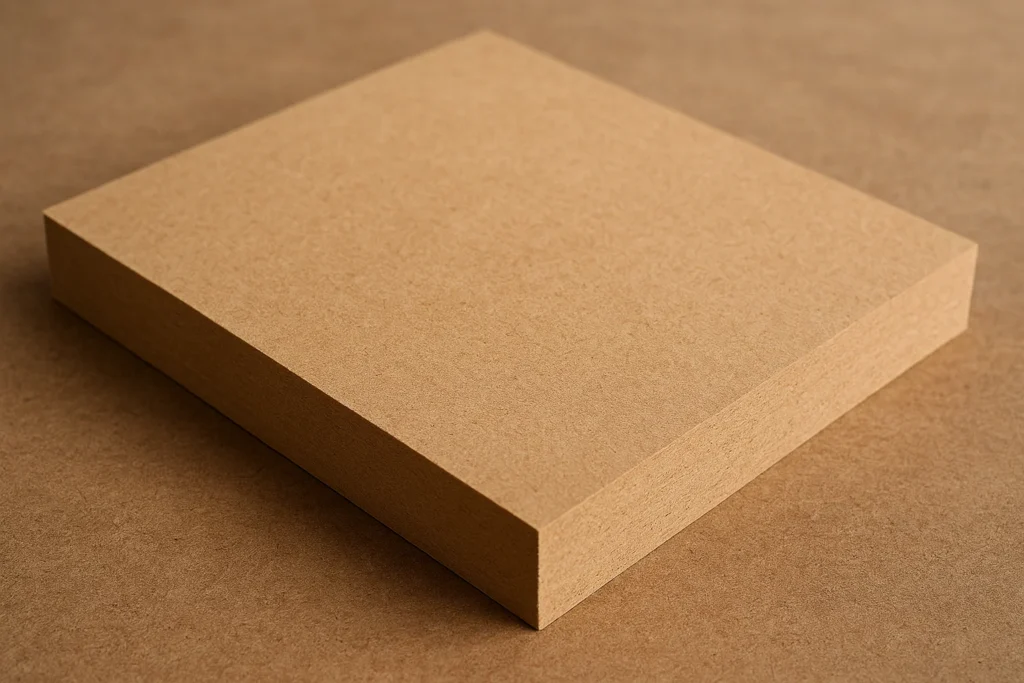
MDF, or medium-density fiberboard, may look like regular wood, but it behaves very differently when you cut it. It’s made from fine wood fibers and resin, pressed into a dense, uniform board.
This structure gives MDF its smooth surface but also makes it tougher on saw blades than plywood or solid wood.
Here’s why choosing the right saw matters:
- MDF dulls blades faster.
The resin and compressed fibers in MDF act like sandpaper on your blade. Using a general-purpose hand saw will wear it out quickly, making cutting harder and messier. - It produces fine, clingy dust.
MDF doesn’t create wood shavings. It releases ultra-fine dust that clogs saw teeth and gets into every corner of your workspace. A saw with the wrong tooth design will gum up fast, slowing you down. - Edges can chip or crumble.
MDF doesn’t have a grain to help guide the cut. Without the right tooth shape and TPI (teeth per inch), you risk rough, splintered edges that ruin your project.
Choosing a hand saw meant for MDF helps you get cleaner cuts, smoother edges, and less effort every time.
Key Features to Look for in a Hand Saw for MDF
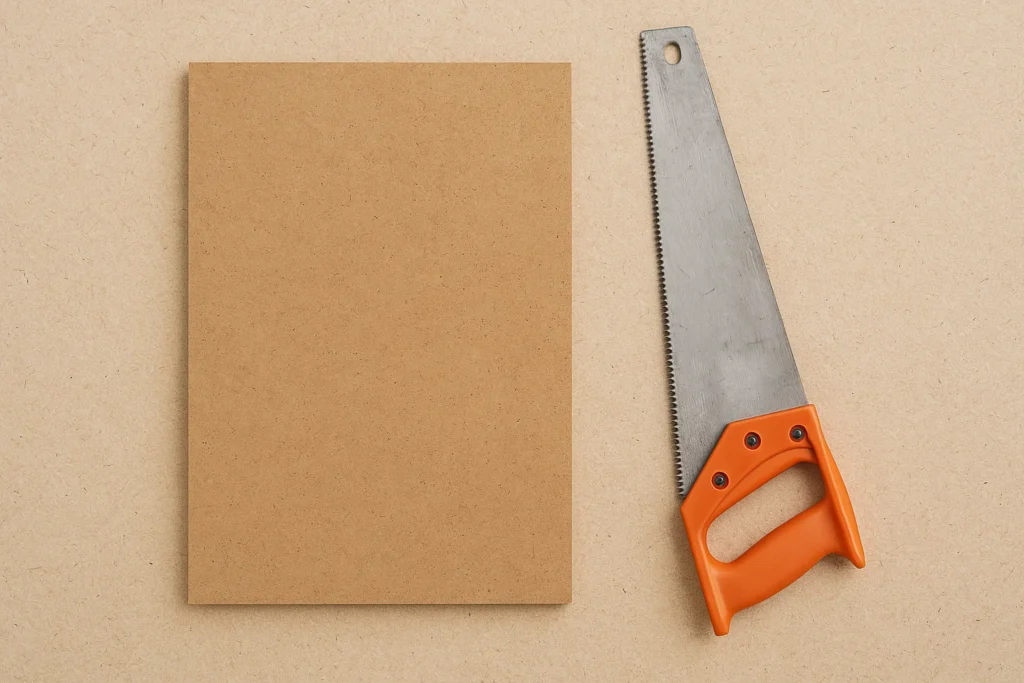
Not all hand saws are built to handle MDF properly. A saw that works great on solid wood may leave chipped edges or wear down too fast when used on MDF.
If you’re buying or comparing saws, these are the features that matter — and how they change depending on what kind of cuts you plan to make.
1. Blade Type
MDF is abrasive. That’s why blade quality matters more than you might expect.
- Hardpoint saws (also called induction-hardened saws) are the best option. Their teeth are heat-treated to stay sharp longer, even when cutting tough materials like MDF.
- Avoid soft steel blades or old-fashioned saws that need frequent sharpening. MDF will dull them quickly, leaving rough cuts.
If you cut MDF often, a hardpoint blade is worth it for the longer life and cleaner results.
2. TPI (Teeth Per Inch)
TPI is one of the most important numbers on any saw. It tells you how fine or coarse the cut will be.
TPI Range | Best For | Pros | Cons |
|---|---|---|---|
6–9 | Rough cutting (not ideal) | Fast cutting | Tears MDF, uneven edges |
10–12 | General MDF cuts | Good balance of speed and smoothness | Slightly slower than coarse |
13–14+ | Fine finish cuts, trim, detail | Cleanest cuts, less chipping | Slower, more effort needed |
Tip: MDF responds better to higher TPI blades. For clean, splinter-free cuts, look for 12 TPI or higher. Only go lower if speed is more important than finish.
3. Tooth Shape and Grind
Tooth shape matters just as much as TPI. The best options for MDF are:
- Triple-ground teeth: These are cut in three angles instead of the usual two. They slice through MDF cleaner and faster, without tearing the edges.
- Fine crosscut or universal grind: These tooth patterns are designed for clean cutting in both directions, which helps prevent surface chipping.
Avoid aggressive ripping teeth or deep gullets — those are made for cutting along the grain in solid wood and will shred MDF edges.
4. Blade Length
A good length keeps your cut smooth and reduces effort.
- 16–20 inches is ideal for general-purpose MDF cutting. This size gives you a full, even stroke without being hard to control.
- If you’re doing small, tight cuts or working in cramped spaces, shorter blades (12–15 inches) can give you more control — but they require more strokes.
5. Handle Comfort and Grip
MDF dust can make your hands slippery. A good handle makes a real difference, especially if you’re cutting for more than a few minutes.
Look for:
- Rubberized or textured grip that stays firm even if your hands get dusty or sweaty
- Angled or ergonomic handles to reduce wrist strain
- Thumb rest or finger grooves if you want more control on precision cuts
Uncomfortable handles don’t just hurt — they can also lead to uneven or jagged cuts from poor control.
6. Replaceable Blades (Optional but Useful)
If you cut MDF often or for work, consider a hand saw with replaceable blades. These usually have solid handles and let you swap in a fresh blade once the old one gets dull.
It saves money long-term and means you never have to work with a worn-out blade. This is especially helpful for detailed work, where a sharp blade makes all the difference.
Choosing Based on How You’ll Use It
Let’s tie it all together. Depending on your needs, here’s how to match saw features to your use case:
1. For clean finish cuts (like trim, shelves, or visible joints):
- Look for 13–14 TPI
- Choose triple-ground teeth
- Go for 16–20 inch blade
- Use a comfortable grip for control
2. For quick, rough sizing (cutting boards to length before sanding or painting):
- 10–12 TPI is fine
- Comfort grip still helps
- Clean edge isn’t as important, so speed matters more
3. For small or shaped cuts (like curves, angles, or tight spaces):
- Shorter blade (12–15 inch)
- High TPI
- Make sure the handle allows full control
4. For frequent cutting (DIYers, workshop use, contractors):
- Replaceable blade saw
- High-quality hardpoint steel
- Comfort handle is a must
Usage Tips for Cutting MDF with a Hand Saw
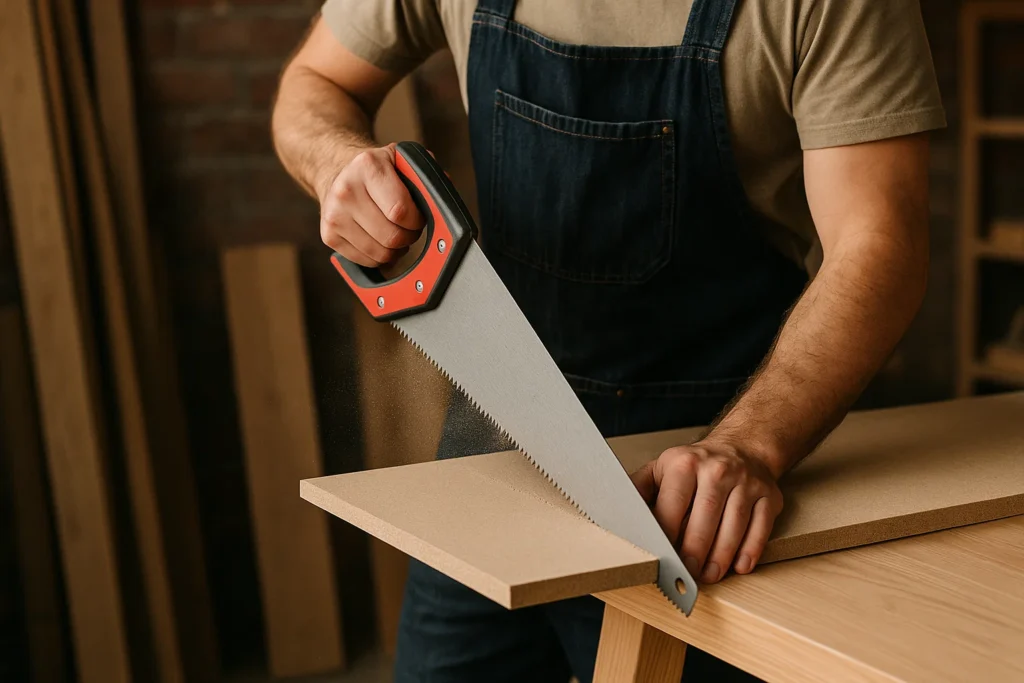
Cutting MDF by hand may seem simple, but doing it the wrong way can lead to chipped edges, uneven cuts, or a lot more effort than necessary.
Here’s how to get the best results while keeping your workspace cleaner and safer.
1. Mark Your Cut Line Clearly
Use a sharp pencil or marking knife to draw your line. Avoid thick markers or dull pencils — they make it hard to stay accurate. For cleaner results, score the cut line with a utility knife before sawing.
This helps prevent the top surface from chipping as the teeth break through.
2. Clamp the Board in Place
MDF is heavier than plywood, but it can still shift or wobble during cutting. Always clamp it to a stable surface.
This gives you full control of the saw and reduces chances of slipping, especially when making longer cuts.
3. Start Slow and Controlled
Begin with light forward strokes to create a shallow groove. Don’t push hard right away.
This starting groove acts like a guide and helps your blade stay straight.
4. Use Long, Smooth Strokes
Once the groove is set, use the full length of the blade. Don’t saw too fast.
Fast, short strokes can heat up the blade and cause more dust, while also tiring your arm faster. Let the teeth do the work — you’re guiding, not forcing.
5. Minimize Dust Exposure
MDF dust is fine and full of adhesives. It’s not good to breathe in. Make sure you:
- Cut in a well-ventilated area
- Wear a dust mask (rated N95 or better)
- Use a vacuum or dustpan to clean up regularly — sweeping just spreads it
Even when cutting by hand, the dust builds up fast. Don’t ignore it.
6. Support the Offcut
As you near the end of the cut, the offcut (the piece that falls away) may break or tear away if unsupported.
Hold it with your free hand or prop it up. This keeps the edge clean and avoids split corners.
Final Thoughts
Cutting MDF well means using a saw built for its dense fibers and resin.
A hardpoint blade with around 10 to 12 TPI balances speed and smooth edges, while higher TPI and triple‑ground teeth deliver cleaner finish cuts.
A comfortable, non‑slip handle reduces fatigue, and a replaceable blade makes heavy use more affordable.
Choose a saw that matches your cutting style and watch your MDF projects look sharper and go more smoothly.
If you see any kind of mistake in our content, make sure to reach out to us.
Frequently Asked Questions (FAQs)
What is the best tool to cut MDF with?
A circular saw fitted with a fine‑tooth, carbide‑tipped blade (60–80 TPI) gives straight, smooth cuts quickly.
For curved cuts, a jigsaw with a high‑TPI blade works well. For small or detail work, a hard‑point hand saw with 12–14 TPI will do the job cleanly.
Can I use a hacksaw to cut MDF?
No. Hacksaws are made for metal and have coarse teeth.
They cut slowly, bind easily, and leave rough edges on MDF. Choose a wood‑cutting blade instead.
Is MDF better than plywood?
Neither is “better” in all cases.
- MDF is smooth, uniform, and cost‑effective. It paints and routes well but is heavy, weak at holding screws, and swells if it gets wet.
- Plywood is stronger, lighter, and holds screws better. It resists warping and moisture but often has surface voids and costs more.
Pick MDF for flat panels and painted surfaces. Pick plywood for structural strength and moisture resistance.
What is the best saw blade for cutting MDF?
Use a carbide‑tipped blade with at least 60–80 teeth and triple‑ground or fine‑crosscut teeth. This design stays sharp longer in abrasive MDF and delivers clean, chip‑free edges.
The Grain Bros was started to serve woodworkers who can’t find products for their specific use case. We found out that there are not many media outlets extensively covering this topic. That’s why, we are here, to do the research and find the perfect products for your next DIY project. So you don’t have to juggle your tools and laptop at the same time.
If you see any kind of mistake in our content, make sure to reach out to us.



